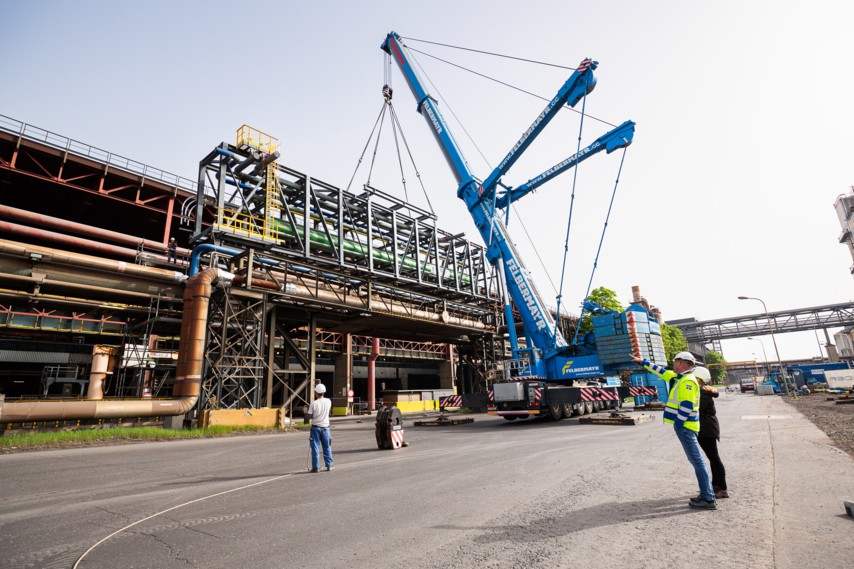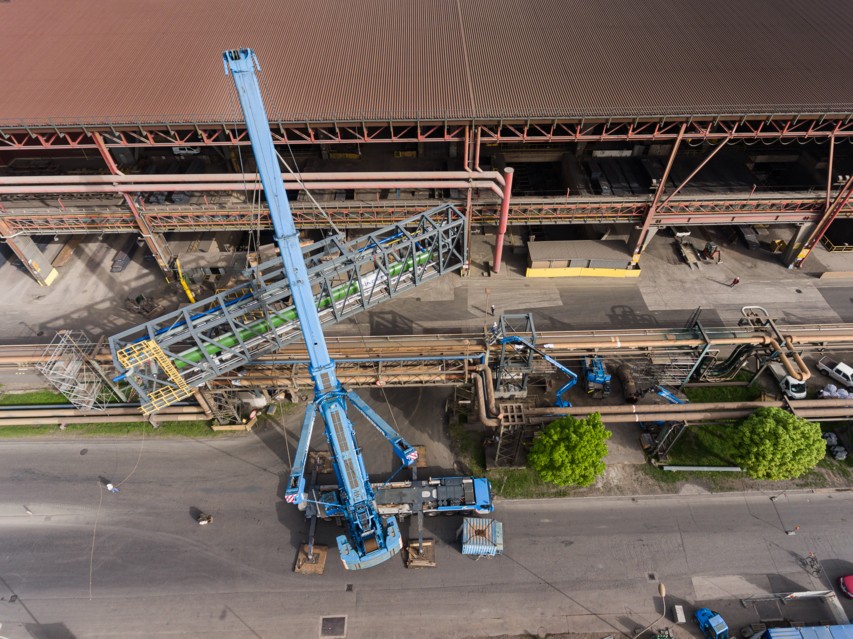Overcoming obstacles with our new scrap transport trolleys
Free travel made possible by raised pipe bridges
As part of the extensive TransMet Utility Supply infrastructure project, two sections of the existing pipe bridges must also be raised to a clear height of 10 meters. This measure is necessary in order to free the transport route for future scrap bucket transports that cannot pass through the previous passageways because they are not high enough.

E+FW pipe bridge: high-precision lifting
At the end of January 2024, the support foundations of the E+FW pipe bridge had to be reinforced. At the same time, pre-assembly of the new bridge section began south of the E+FW line. It took two months for the new part of the E+FW pipe bridge to be assembled at the pre-assembly site south of the route and to equip it with the pipelines for coke gas, oxygen, argon, nitrogen, natural gas, steam and steam condensate. Three pneumatic dispatch lines also had to be taken into consideration in addition to the utility lines. The 120-ton pipe bridge was lifted onto its piers using a heavy-duty crane on 9 April. This high-precision and highly coordinated task was a key milestone in the progress of the project. The first utility lines have already been successfully sealed; and the final oxygen lines will not be completed until March 2025 during the planned LD3 standstill. The lower part cannot be dismantled and the lift completed until the functionality and safety of all the cables have been verified.
N pipe bridge: efficient adjustments
The N pipe bridge also requires adaptation. An efficient and innovative solution has been found that does not involve raising the entire structure. Instead, only one industrial water pipe will be raised, and this will save substantial time, work and costs. The steel structure of the N pipe bridge is reinforced by an overhead structure to ensure stability and safety. Relocation of the piping is scheduled for next June, while reinforcement of the steel structure is expected to be completed by the end of the year. In addition to these measures, the power lines must also be installed in final position in order to ensure full operational capability of the infrastructure.

Future-proof transport route
The routes for the new scrap transport vehicles will be fully usable as soon as all work has been completed. This project shows how intelligent engineering solutions and precise planning can adapt existing infrastructures to new requirements without the need for extensive new buildings. Successful adaptation of the E+FW and N pipe bridges ensure that transport operations can continue smoothly and efficiently.
Conclusion: a milestone for the future
The greentec steel program impressively demonstrates how innovative approaches and careful planning can overcome technical challenges. Successful lifting of the E+FW pipe bridges and efficient adaptation of the N pipe bridge are groundbreaking steps that sustainably improve scrap transports. These measures not only meet current needs, but also lay the foundation for meeting future requirements. The unrestricted usability of the new routes ensures that transport operations can be continued smoothly in the future.
To greentec steel
The greentec steel project of voestalpine is an ambitious step-by-step plan that makes a valuable contribution to the achievement of the climate goals. As a first step, the voestalpine Group plans to replace two blast furnaces with two electric arc furnaces (EAFs) by the year 2027. The investment volume amounts to roughly 1.5 billion euros.
CO2 emissions can be reduced by up to 30% as early as 2027 by making this switch from the blast furnace to the EAF. This corresponds to a savings of nearly 4 million tons of CO2 per year, amounting to almost 5% of the carbon emissions in Austria. This makes greentec steel the largest climate protection program in Austria.
The two electric-arc furnaces will enable voestalpine to produce roughly 2.5 million tons of carbon-reduced steel by the year 2027, roughly 1.6 million tons in Linz and 850,000 tons in Donawitz.
